A while back, I told you all about this small piece of the biochemistry of the fly eye — the pathways that make the brown and red pigments that color the eye.
I left it with a question: if even my abbreviated summary revealed considerable complexity, how could this pathway evolve? Changing anything produces a failure or change in the result. Before I answer, let’s make the problem even harder, because I love a challenge (although actually, I’m cheating — it’s going to turn out that complexity is not a barrier, but an opportunity).
The pigment pathways above are far downstream: they operate in the differentiated compound eye of the fly. Long before that, there are a set of genes that have to be activated first to trigger formation of the head and eye in the larva. And this is that pathway:
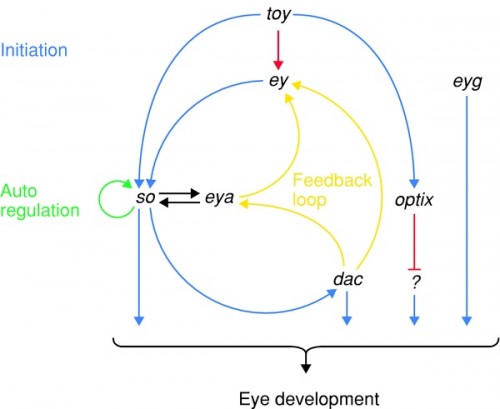
Regulatory scheme on the top of the eye developmental pathway. Twin of eyeless (toy), eyeless (ey), and possibly eyegone (eyg), three Pax genes, are master control genes on the top of the hierarchy. Sine oculis (so), eyes absent (eya), dachshund (dac), and optix are second-order transcription factors regulated by the master control genes. Note that the pathway is not linear, but rather a network interconnected by feedback loops.
At the top of the hierarchy are two genes in Drosophila, eyeless (ey) and twin of eyeless (toy). Remember, genes are named for their mutant effect, so the normal function of eyeless is to initiate eye development. These genes switch on sine oculis and eyes absent (notice the effort to find synonyms to describe genes that cause missing eyes when broken) that activate each other and feed back on eyeless to generate a robust response. Another gene, dachshund (this one named for another part of its phenotype: it makes flies with very short legs) also feeds back on eyeless.
This circuit has multiple outputs: so, dac, optix and eyg. All of these have effects further downstream, in that catch-all category labeled “eye development” here. In that broad label lie multiple processes: the pigment pathways above, but also all kinds of elaborate interactions that recruit cells to specific photoreceptor functions, that organize supporting cells, like hair cells and lenses, and that induce the neural tissue of the retina and deeper parts of the nervous system. The genes ey and toy initiate a whole deep, branching network of genes that cascade together to build the many bits and pieces of the eye.
These two master control genes, eyeless and twin of eyeless, also have a synonym. To everyone’s surprise, versions of this circuit are found in all animals with eyes, and the common name for this universal regulator of eye formation is Pax6, and that’s what I’ll call it in the rest of this article.
And look at this! Isn’t it cool? All these eyes use this same Pax6 gene regulatory network to initiate development.
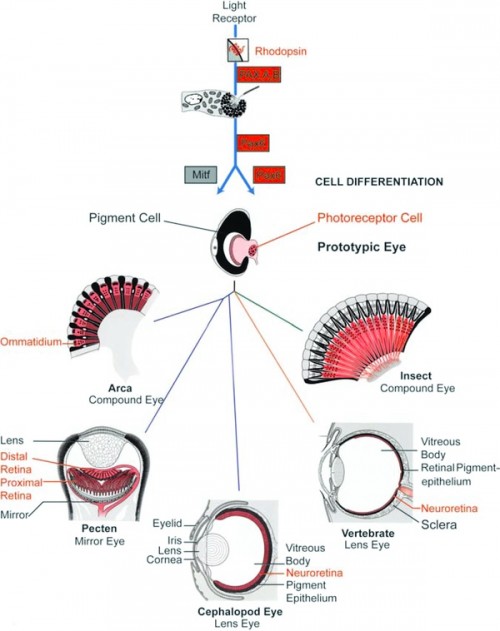
General scheme of eye evolution. The first step in eye evolution is the evolution of a light receptor molecule which in all metazoans is rhodopsin. In the most ancestral metazoa, the sponges, a single Pax gene, but no opsin gene has been found. In the cubozoan jellyfish Tripedalia, a unicellular photoreceptor has been described in the larva. The adult jellyfish has complex lens eyes that form under the control of PaxB, whereas the eyes of a hydrozoan jellyfish (Cladonema) are controlled by PaxA. We propose that from the unicellular photoreceptor cell, the prototypic eye postulated by Darwin originated by a first step of cellular differentiation into a photoreceptor cell and a pigment cell, controlled by Pax6 and MITF, respectively. From this prototype, all the more complex eye types arose monophyletically. As a mechanism, we propose intercalary evolution of progressively more genes such as lens genes into the eye developmental pathway (after Gehring and Seimiya 2010). Starting from the common prototype, the various eye types evolved by divergent, parallel, and convergent evolution, generating a magnificent biodiversity.
That’s the power of a gene regulatory network. Switch on just one of the key genes, and it recruits all the downstream genes and triggers a whole series of actions to assemble a complex structure. That strange grey object to the right is a developing Drosophila wing — the dark fringe is the line of bristles that surround the leading and trailing edges of the fully-formed wing — which has had the Pax6 gene inappropriately expressed in a few cells at the base. Just switching on that one gene has led to the construction of an eye with its red pigment right there, where flies should not have eyes.
The ability to build elaborate organs with a simple switch is a reflection of the modular nature of developmental programs. It also simplifies evolution; small, simple changes can lead to dramatic novelties. Zap, one mutation can lead to an abrupt saltational change.
Now wait a moment, you will say. Suddenly plopping an eye onto a wing sounds disastrous: it really is a kind of hopeful monster, emphasis on “monster”, and is almost always going to be grossly deleterious. This can’t be a viable pathway for evolutionary change, can it? And you’d be right. But what about portions of a pathway? Look back up at the eye development pathway, the second figure in this article. What if you just switched on optix, one of the second-order transcription factors? Then you’d just activate some of the tools of eye construction.
It’s been done. The hideous blob to the left is the nascent antenna of a fruit fly, and optix has been inappropriately switched on…and what do you get? It activates the pigment pathway (that biochemical sequence illustrated in the first image at the top of this page), and it creates a bright red spot on the antenna. This is non-trivial; it means the precursors and transporters are all at work, and all the enzymes in the xanthomattin and drosopterin pathways are doing their job. One switch, and you get a whole hierarchy of genes producing a complex output. This could be one way new traits appear, by redeploying genes from established pathways.
Saying they could isn’t the same as saying they did, of course. But here are a few examples that suggest that eye network genes have been redeployed to create morphological novelties. In Heliconius butterflies, for instance, the red spots on their wings can be traced back to embryonic patterns of expression of optix in the developing wings.
Heliconius butterflies express optix in wing epidermal cells that will produce red ommochrome pigments. A: Heliconius erato. B: Forewing and hindwing patterns from different races of H. erato (top: H. e. petiverana; bottom: H. e. erato). C: Pupal wings expressing optix mRNA in a pattern corresponding to the areas of red pigment in wings depicted in (B).
Even more dramatically, here’s an extinct biting midge preserved in amber, and look at that wing: what was I saying about switching on eye genes inappropriately in the wing would be deleterious? I was wrong. This is an insect with a compound eye growing in its wing.

A. The extinct biting midge, Eohelea petrunkevitchi, with a unique wing organ that resembles the surface of its compound eye. B: The dorsal surface of the wing organ. C: The midge’s compound eye. D: The ventral surface of the wing organ.
It’s extremely unlikely that that alar eye functioned as a visual organ: any photoreceptor signals coming from a platform flapping several times a second would be hopelessly confusing. Most likely what it was was a species-specific sexual signal, like the spots on many fly wings — this one is just more elaborately structured and expensive than most. Alternatively, one hypothesis for the formation of spots on insect wings is that they are intended to resemble eyes — large eyes, far apart, making the animal look much larger to predators — so Eohelea may have just been carrying the eyespot mimicry to an extreme. Either way, building these eyes is developmentally trivial.
It may also represent a transitional state: first the initiator of a genetic cascade is co-opted and expressed at a novel time or place, and then selection can hone it down over time, adding new control points that, for instance, suppress irrelevant ommatidium formation in the alar eye while allowing the functional pigment expression to continue.
One last example: this is the Cambrian worm, Microdictyon. Notice anything unusual?

Microdictyon sinicum, a Cambrian Lobopodian fossil from Chengjiang (China) with compound eye on every annulus (segment) above every leg. (A) Reconsruction (after Bergström and Hou). (B) Lateral view.
There’s a pair of eyes in the head, where you’d expect them…but all those other eyes along the sides are morphologically indistinguishable from the anteriormost pair. There is some argument about whether these structures actually are eyes, but they are definitely hexagonal arrays that closely resemble the hexagonally structured ommatidia of the compound eyes of insects. If they weren’t functional eyes, it seems likely that they are at least produced by the redeployment of the structural genes of the compound eye.
And if they were functional eyes, well, that is just freakin’ cool.
The bottom line, though, is that because complex developmental networks are functionally constrained — think of them as software modules that respond to molecular inputs and produce morphological outputs — their complexity is not a barrier to evolution at all, but instead provide opportunities for generating interesting evolutionary novelties.
Gehring WJ (2012) The animal body plan, the prototypic body segment, and eye evolution. Evolution & Development 14(1):34-36.
Monteiro A (2012) Gene regulatory networks reused to build novel traits. Bioessays 34:181-186.
(Also on Sb)

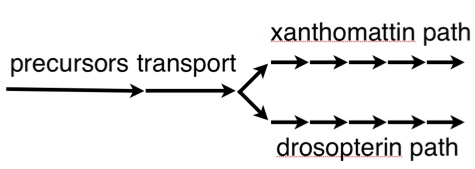
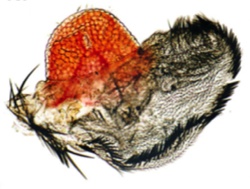
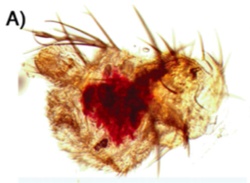

It’s like evolution listened to a motivational speaker from the 80s!
That’s a cool pic (the artist’s impression). I think I’m going to have to develop some D&D stats for a giant, carnivorous, (of course) version of that!
Bwahahahaaaa
If evolution were true, we’d be made up of bits and pieces of systems that weren’t designed for their present purposes.
Not like the great de novo designs that we see in life.
Or, um, did I get that last bit wrong?
Glen Davidson
Fascinating.
Nature 484:145 has a “research highlight” report on vision in the larva of the sponge Amphimedon queenslandia, which appears to use a cryptochrome rather than an opsin in its “ring eye”. The reference is to J.Exp.Biol. 215:1278-86. The authors apparently suggest this is “a separate lineage of eye evolution”.
Yeah, I’m so totally going to stat me up some Cambrian worm!
–
Wow, that’s taking the old “eyes in the back of my head” thing a bit far. Imagine the parallax and 3D processing opportunities of having a row of eyes along, say, a Tiger sized body. You might think of it as a good prey species protection strategy but how useful would it have been to our arboreal ancestors as a surround-vision multi-target track-while-scan radar analogue? Not to mention the laser emitting specialisations. Want some of them…
Really interesting; it’s pretty amazing how these pathways can be reworked in such fascinating ways and can actually be adaptive in completely different environments or selective pressures. Well, it’s cool to me, anyway.
Thanks for posting this PZ. I always shudder when the religious ask me a question along the lines of “without god, where do you find wonder and awe in the universe?” or some such nonsense. One answer can be found in posts like this one. Thanks.
Daddy like.
You guys know that Microdictyon is less than an inch long, right?
Why do creationists spend so much time on protein building genes, and zero time on regulatory genes and clusters thereof. [/rhetorical]
Good explanation PZ. Not surprised at the results.
Wow, that is amazing!
@PZ
Who said D&D had to be realistic? :)
And I thought that was just a rumor espoused by your more prurient detractors.
That’s just what they want you to think…
But it’s a very cool looking inch.
Geez, PZ. I never figured you for a size queen.
PZed:
Well, yes, that why the D&D version is going to be called Megadictyon. >:-)
Definitely cool all around. Cool worm, too. Have fun stating up the grossly oversized D&D version, guys. Definitely a candidate for “All-Around Vision (can’t be flanked)” or something like that.
Back on the modular aspect, it makes me wonder how many suppressed and modified odds and ends I might be sporting as a vertebrate.
Macrodictyon
Size/Type: Huge Magical Beast
Hit Dice: 12d8+54 (109 hp)
Initiative: +8
Speed: 60 ft. (12 squares), climb 60 ft.
Armor Class: 20 (-1 size, +8 Dex, +3 natural), touch 18, flat-footed 12
Base Attack/Grapple: +6/+23
Attack: Bite +13 melee (2d8+1 plus paralysis)
Full Attack: Bite +13 melee (2d8+1 plus paralysis) and 10 legs +11 melee (2d6+1)
Space/Reach: 15 ft./10 ft.
Special Attacks: Improved Grab, Swallow Whole, Paralysis
Special Qualities: All-Around Vision, Darkvision 60 ft., Light Sensitivity, Fast Healing 12
Saves: Fort +12, Ref +14, Will +5
Abilities: Str 13, Dex 26, Con 22, Int 2, Wis 10, Cha 9
Skills: Climb +32, Spot +30
Feats: Weapon Finesse
Environment: Underground
Organization: Solitary
Challenge Rating: 8
Advancement: 12-18 HD (Huge), 19-24 (Gargantuan)
The Macrodyctyon is large, segmented, vaguely caterpillar-like creature that dwells deep underground. The Macrodyctyon is an ancient creature, having survived through the ages in underground caverns and mushroom forests, feeding off the many other denizens of the Underdark and always growing ever larger. It’s thick, rubbery skin and poisonous nature means that it has few natural predators, though other large carnivores will of course seek to drive it from their territory. (Some intelligent races consider the eyes to be a delicacy.) It has enormous compound eyes all the way down it’s entire body, rendering immune to being flanked by enemies on multiple sides and giving it excellent awareness of its surroundings.
It is usually carnivorous but can resort to eating lichen and fungus if driven to starvation. At extremity, it can even devour it’s own extremities – they grow back over the course of a week after the creature has found suitable food supplies. It’s primary weakness is light – unless the creature is extremely hungry it can normally be driven off with the light of a torch. In bright sunlight (or within the radius of a daylight spell) it is dazzled and will seek to flee into darkness unless prevented or actually starving.
Due to it’s incredibly hardy nature and supernatural healing ability, it is nearly impossible to kill except through starvation. It reproduces by binary fission – once it has reached a certain size, it splits into two identical creatures, each with half the hit dice of the original beast. This process takes approximately 8 hours.
It has as many segments as it does Hit Dice, and if it is somehow injured in such a was as to remove whole segments, it’s Hit Dice are reduced accordingly.
Combat
The Macrodictyon’s favorite tactic is to isolate a single prey creature and swallow it whole, relying on it’s poison to subdue it’s meal once eaten. The Macrodictyon is extremely fast and agile, and climbs up walls and accross ceilings as easily as most creatures walk across the floor.
Improved Grab (Ex)
To use this ability, a Macrodictyon must hit a creature at least one size smaller than itself with its bite attack. It can then attempt to start a grapple as a free action without provoking an attack of opportunity. If it wins the grapple check, it establishes a hold and can try to swallow the opponent in the following round.
Swallow Whole/Paralysis (Ex)
A Macrodictyon can try to swallow a grabbed opponent by making a successful grapple check. Once inside the beast’s mass, the opponent must succeed on a DC 20 Fortitude save or be paralyzed for 3d6 rounds by the Macrodictyon’s digestive juices, taking 2d6 points of acid damage per round. A new save is required each round inside the beast. The save DC is Constitution-based. A swallowed creature that avoids paralysis can climb out of the mass with a successful grapple check. This returns it to the creature’s maw, where another successful grapple check is needed to get free. A swallowed creature can also cut its way out by using a light slashing or piercing weapon to deal 25 points of damage to the Macrodictyon’s interior (AC 14). Once the creature exits, the creature’s regenerative capacity closes the hole; another swallowed opponent must cut its own way out. A Huge Macrodictyon’s interior can hold 2 Large, 8 Medium, 32 Small, 128 Tiny, or 512 Diminutive or smaller opponents.
Fast Healing (Ex)
Each round, a Macrodictyon heals damage equal it’s number of hit dice.
Oh that would have been better. Ah, well.
Not by the time I’m done with it!
–
Indeed!
I may even assign hit points on a per-segment basis, and allow as how the segments can, if separated, act independently.
*sinister guffaws*
–
I love the evo devo posts! Thanks, PZ.
Bereft of useful scientific knowledge here but one thing I do know…those illustrations of the compound insect eyes look just like Caine’s punk ducky’s hair!!
P.Z. thanks for this. Even though I am not a biologist, I find this stuff amazing.
Keep it coming,
Cheers!
Donny
Why do they concentrate on proteins instead of regulatory genes?
Because they’re 80 years behind the times.
Single-celled organisms with one or a few flagella have droplets of light-sensitive pigment at the base of the flagellum, so that light conditions can influence where the organism goes. Eyes are primoridally basic.
Is that midge with the eye in its wing thought to be a mutational oddity or a normal member of its species?
All nerditry aside, I do also quite enjoy these posts.
Very well done PZ. It’s sweet to see stuff you work with every day pop up on Pharyngula. More of these posts please!
There are multiple species of Eohelea that show the curious eye spot, and they do vary in the degree of similarity to an eye. But it’s definitely not just one oddball midge.
Also this:
http://www.newscientist.com/article/dn18627-eyeless-hydra-sheds-light-on-evolution-of-the-eye.html
I’ll happily echo the answer of whoever said upthread ‘But where do you find wonder and awe?’. I love this stuff.
Thanks, PZ!
I found an article about the Amphimedon queenslandica genome and and its complex genetic system for controlling its cell cycle, growth, and apoptosis, with color-coding for which kind of organisms the various parts came from. Some, of course, are ancient. The diagrams have to be viewed large to be appreciated.
As you all probably know, sponges don’t have nerve cells but they do have the biochemistry for transmitting nervous impulses throughout the sponge body. Just as we had sex cells before we had internal fertilization and haemoglobin before we had veins, we had nerve-signal transmission before we had nerves. Our commonality goes deep into our evolutionary history.
this article highlights the genius of biology (nature) to surpass mere human imagination at solving problems. Real biology is why I find sci-fi creations of alien creatures so implausible they are seldom more than cartoons or guys in rubber suits.
and to think that the eye is just one example out of many that could be given.
the god did it crowd do not even understand what happened let alone any evidence for god did it.
uncle frogy
I would suspect, though, that once one does all the relevant math and physics, one will find that the ideal setup, giving the best parallax and 3D processing and field of view for the most efficient use of resources and the best protection for a vulnerable sense organ, will end up to be a pair of eyes, appropriately placed and endowed with sufficient mobility.
It does follow a fairly standard evolutionary pattern in animal body design – to start with multiple duplicated structures with very similar design and great redundancy in overlap of function, and from that starting point move on to increasingly specialize the different serial homologs while simultaneously paring down the total number of repeats, losing redundancy but gaining efficiency and efficacy.
Come to think of it, its really the exact same process with duplicated genes, too.
(Note that this process automatically produces so-called “irreducibly complex” end results).
I looked Microdictyon sinicum up on Wikipedia, and it refers to these eyes as sclerites. Can someone with wiki skills update this please?
A real eye-opening article. Sorry about that. In all seriousness, these scientific articles are one of the key reasons I keep coming back to your site, PZ. Thanks.
Quick question to everyone here: In the third graphic, which shows the evolution of multiple eye anatomies from a prototypical eye, there is a tree shown with distinct branches and colours.
This tree does not seem to agree with the anatomy and with a possible evolutionary tree.
For example the cephalopod and vertebrate eyes are both shown with a neuroretina, which the other eyes lack, but that does not seem to tally with the branching.
Is the branching in the diagram phylogenetic? Or an accident in the creation of the diagram?
If not phylogenetic, are specific named tissues (like the neuroretina) convergent? Or are there shared genes and pathways across all lens development in single-lensed eyes?
I don’t understand one damn word of this post. That must mean that Darwin was right and the eye is too complex to have evolved. Am I right?
Squee!
Sorry.
The whole concept of Pax genes and regulatory functions and such just makes me all warm and fuzzy inside. I had to re-read the parts in Dawkins’ books about the expression of Pax genes a few times to really “get” it, and I sure as hell am not an expert, but once it clicked and I saw how beautifully simple it all is, segmented body plans and expression along the length etc, it was an amazingly “ah-ha!” moment. How could anyone WANT to believe this was all just “made” by a sky dude? It’s so incredible how it all comes together! There simply isn’t anything as beautiful or as awe-inspiring to me than the development of these millions upon millions of life forms from what must have originally been self-replicating molecules.
billydee #37
No, just means you’re ignorant.
Yep.
But of course, ignorance is fixable, for those who have the will.
Hmm… if you had lots of functional vertebrate eyes, would it be like having a huge compound eye? Or would it just give you a headache?
I guess you didn’t catch the devilish gleam in my eye as I typed my post.
Well creationists ignore regulatory pathways because they werent “a thing” when the big group the set up creation science were around. The foundation of It is so toxic that they cannot hope to actually be involved in research, and probably can’t even really get much from any level of biology education. They really do argue from a position decades out of date. The only deviation from that I’ve seen is essentially psychobabble meant to look current.
Anyway as for this I’m a bit bothered that the actual origin of such a pathway didn’t even get a hypothetical explanation. You can put two and two together and recognize “oh, they took it from other systems” but I don’t expect that to click for people not yet familiarized with this sort of thing.
This bio stuff is why i’m really visiting Pharyngula.
Awesome.
what is this I don’t even
Wha… those were supposed to be calcareous armor plates. They’re eyes!?!
*pretending to be able to raise one eyebrow*
Fascinating.
So perhaps arthropod eyes first appeared on every segment and were then restricted to the first…
Oh, lots. PZ, please blog about gill arches again. :-) Also, extremities used to come in lines, like milk lines: the forelimbs are the last of a vertical series behind the gills, the hindlimbs the last of a horizontal series.
You combined it with a nemertean :-)
:-o
Yes.
Yes.
Vertebrate and cephalopod eyes are heavily convergent. Indeed, nautilus eyes lack lenses. Arca and Pecten are bivalves – fellow mollusks of the cephalopods.
@david: thanks – fuckin’ awesome.
I knew that cephalopod eyes were convergent with the vertebrates (how could you come to _this_ blog and not know about cephalopoda). However I had been confused with the (presumably historical accident) of the tissue labels. With further reading, there is also confusion with the word ‘Pecten’ being both a mollusc and also a structure in eyes of birds. Ho-hum.
Wait a minute. This stuff about Microdictyon needs some backing up. First, calling it a worm is a bit odd. It’s an armored lobopod, and perhaps a stem-onychophoran.
Second, I’d like a bit more documentation for the idea that those plates are eyes. Looked at in a phylogenetic context, they’re armor. And the armor of other armored lobopods looks much less like any sort of compound eye. For a well-known example, consider the spines of Hallucigenia, which are clearly homologous to Microdictyon‘s plates. Are those modified compound eyes? It’s going to take more than a mention of hexagonal arrays to convince me, unless you want to claim that honeycombs are compound eyes. Is there any evidence that any genes in the eye development pathway were recruited in forming the lobopods’ armor?
Let’s be a little more skeptical about paleontological reconstructions.
I want to make a motion on instituting the death penalty for anyone who uses that stupid quip.
I’m confused. Which stupid quip?
johnharshman: Is the identity of those structures under debate in the literature anywhere?
Ing: being skeptical of palaeontological reconstructions makes a lot of sense…not that palaeontologists are being disingenuous or incompetent, but just that what they are trying to do is hard. Circumspection is de rigeur.
Antiochus:
If you mean the “eyes” of Microdictyon, PZ’s post is the first time I’ve ever seen them referred to as eyes. There are many species of armored lobopods, and none of the others have plates that look anything like compound eyes. Isolated Microdictyon plates are a common part of the Early Cambrian “small, shelly fauna”, and nobody ever claimed they were compound eyes. Now that we have whole-body fossils in the Chengjiang, and given the fact that one pair of plates is located in the neighborhood of what we might call the head, that connection has apparently been made. Apparently. I don’t know the paper in question, and PZ doesn’t cite it, except for an attribution of a figure to “Bergström and Hou”. A little googling shows that the hypothesis comes from Dzik (2003). But as Zhang and Aldridge (2007) point out, it’s just incompatible with the morphological variation of plates within the genus Microdictyon, much less other armored lobopods. What we have is actually an armor plate with holes in it. Dzik speculated that the holes might once have contained lenses. Zhang and Aldridge explain why that’s unlikely.
Bergström, L., and Hou, Y.-G. 2001. Cambrian onychophora or xenusians. Zoologischer Anzeiger 240:237-245.
Dzik, J. 2003. Early Cambrian lobopodian sclerites and associated fossils from Kazakhstan. Palaeontology 46:93-112.
Zhang, X.-G., and Aldridge, R. J. 2007. Development and diversification of trunk plates of the Lower Cambrian lobopodians. Palaeontology 50:401-415.
johnharshman: Thanks!